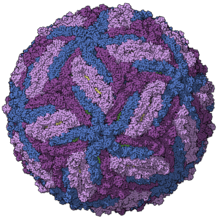Flaviviridae
Flaviviridae is a family of viruses. Humans and other mammals serve as natural hosts. They are primarily spread through arthropod vectors (mainly ticks and mosquitoes). The family gets its name from the yellow fever virus, the type virus of Flaviviridae; flavus is Latin for "yellow", and yellow fever in turn was named because of its propensity to cause jaundice in victims.[2] Currently, 89 species are in this family, divided among four genera.[3][4] Diseases associated with this family include: hepatitis (hepaciviruses), hemorrhagic syndromes, fatal mucosal disease (pestiviruses), hemorrhagic fever, encephalitis, and the birth defect microcephaly (flaviviruses).[4][5]
| Flaviviridae | |
|---|---|
 | |
| Yellow fever virus | |
 | |
| Zika virus capsid model, colored by chains, PDB entry 5ire[1] | |
| Virus classification | |
| (unranked): | Virus |
| Realm: | Riboviria |
| Kingdom: | Orthornavirae |
| Phylum: | Kitrinoviricota |
| Class: | Flasuviricetes |
| Order: | Amarillovirales |
| Family: | Flaviviridae |
| Genera | |
Taxonomy
This family has four genera:[3][4]
- Genus Flavivirus (type species Yellow fever virus, others include West Nile virus, Dengue virus, and Zika virus).
- Genus Hepacivirus (type species Hepacivirus C (hepatitis C virus), also includes Hepacivirus B (GB virus B))
- Genus Pegivirus (includes Pegivirus A (GB virus A), Pegivirus C (GB virus C), and Pegivirus B (GB virus D))
- Genus Pestivirus (type species Pestivirus A (bovine viral diarrhea virus 1), others include Pestivirus C (classical swine fever virus, previously hog cholera virus)). Viruses in this genus infect nonhuman mammals.
- Unclassified
Other flaviviruses are known that have yet to be classified. These include Wenling shark virus.
Jingmenvirus is a group of unclassified viruses in the family which includes Alongshan virus, Guaico Culex virus, Jingmen tick virus and Mogiana tick virus. These viruses have a segmented genome of 4 or 5 pieces. Two of these segments are derived from flaviviruses.
A number of viruses may be related to the flaviviruses, but have features that are atypical of the flaviviruses. These include citrus Jingmen-like virus, soybean cyst nematode virus 5, Toxocara canis larva agent, Wuhan cricket virus, and possibly Gentian Kobu-sho-associated virus.
Genome

Members of the family Flaviviridae have monopartite, linear, single-stranded RNA genomes of positive polarity, 9.6 to 12.3 kilobase. The 5'-termini of flaviviruses carry a methylated nucleotide cap, while other members of this family are uncapped and encode an internal ribosome entry site.
The genome encodes a single polyprotein with multiple transmembrane domains that is cleaved, by both host and viral proteases, into structural and non-structural proteins. Among the non-structural protein products (NS), the locations and sequences of NS3 and NS5, which contain motifs essential for polyprotein processing and RNA replication respectively, are relatively well conserved across the family and may be useful for phylogenetic analysis.
Virion structure
Virus particles are enveloped, with icosahedral and spherical geometries, about 40–60 nm in diameter.[4][5]
| Genus | Structure | Symmetry | Capsid | Genomic arrangement | Genomic segmentation |
|---|---|---|---|---|---|
| Hepacivirus | Icosahedral-like | Pseudo T=3 | Enveloped | Linear | Monopartite |
| Flavivirus | Icosahedral-like | Pseudo T=3 | Enveloped | Linear | Monopartite |
| Pegivirus | Icosahedral-like | Pseudo T=3 | Enveloped | Linear | Monopartite |
| Pestivirus | Icosahedral-like | Pseudo T=3 | Enveloped | Linear | Monopartite |
Lifecycle
Viral replication is cytoplasmic. Entry into the host cell is achieved by attachment of the viral envelope protein E to host receptors, which mediates clathrin-mediated endocytosis. Replication follows the positive-stranded RNA virus replication model. Positive-stranded RNA virus transcription is the method of transcription. Translation takes place by viral initiation. The virus exits the host cell by budding. Humans and mammals serve as the natural hosts. The virus is transmitted via vectors (ticks and mosquitoes).[4][5]
| Genus | Host details | Tissue tropism | Entry details | Release details | Replication site | Assembly site | Transmission |
|---|---|---|---|---|---|---|---|
| Hepacivirus | Humans | Epithelium: skin; epithelium: kidney; epithelium: intestine; epithelium: testes | Clathrin-mediated endocytosis | Secretion | Cytoplasm | Cytoplasm | Sex; blood |
| Flavivirus | Humans; mammals; mosquitoes; ticks | Epithelium: skin; epithelium: kidney; epithelium: intestine; epithelium: testes | Clathrin-mediated endocytosis | Secretion | Cytoplasm | Cytoplasm | Zoonosis; arthropod bite |
| Pegivirus | Mammals | None | Clathrin-mediated endocytosis | Secretion | Cytoplasm | Cytoplasm | Unknown |
| Pestivirus | Mammals | None | Clathrin-mediated endocytosis | Secretion | Cytoplasm | Cytoplasm | Vertical: parental |
Clinical importance
Major diseases caused by members of the family Flaviviridae include:
- Dengue fever
- Hepatitis C
- Japanese encephalitis
- Kyasanur Forest disease
- Murray Valley encephalitis
- St. Louis encephalitis
- Tick-borne encephalitis
- West Nile encephalitis
- Yellow fever
- Zika fever
References
- Sirohi D, Chen Z, Sun L, Klose T, Pierson TC, Rossmann MG, Kuhn RJ (April 2016). "The 3.8 Å resolution cryo-EM structure of Zika virus". Science. 352 (6284): 467–470. Bibcode:2016Sci...352..467S. doi:10.1126/science.aaf5316. PMC 4845755. PMID 27033547.
- "Flaviviridae". Microbe Wiki. Retrieved July 22, 2008.
- Simmonds, P; Becher, P; Bukh, J; Gould, E; Meyers, G; Monath, T; Muerhoff, S; Pletnev, A; Rico-Hesse, R; Smith, D; Stapleton, J; ICTV Report Consortium (2017). "ICTV Virus Taxonomy Profile: Flaviviridae". Journal of General Virology. 98 (1): 2–3. doi:10.1099/jgv.0.000672. PMC 5370391. PMID 28218572.
- "Flaviviridae". ICTV Online Report.
- "Viral Zone". ExPASy. Retrieved 15 June 2015.
External links
- ICTV Report: Flaviviridae
- Flaviviridae Genomes database search results from the Viral Bioinformatics Resource Center
- Viralzone: Flaviviridae
- Virus Pathogen Database and Analysis Resource (ViPR): Flaviviridae
- "Flaviviridae". NCBI Taxonomy Browser. 11050.